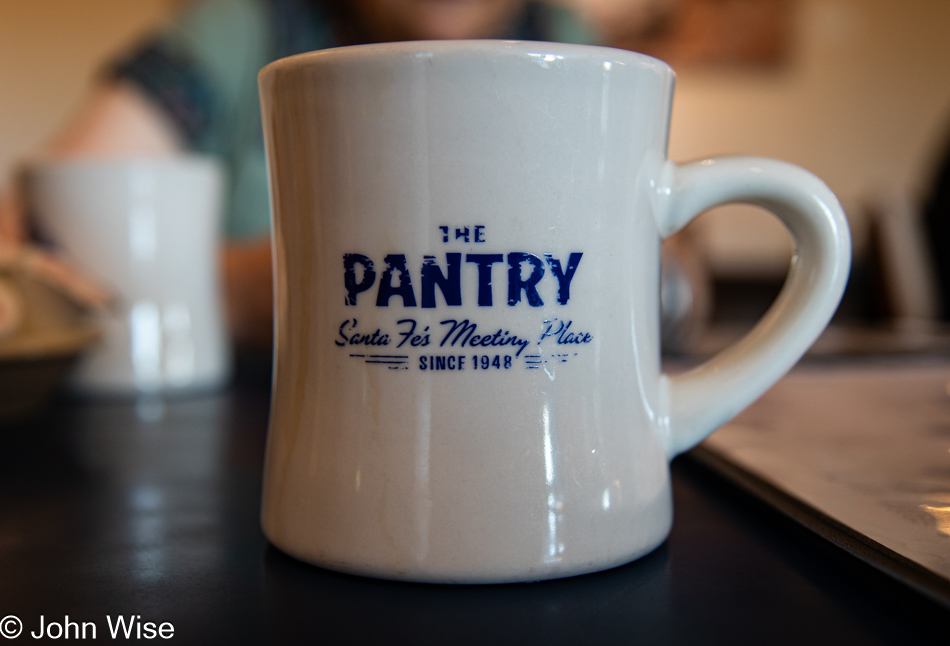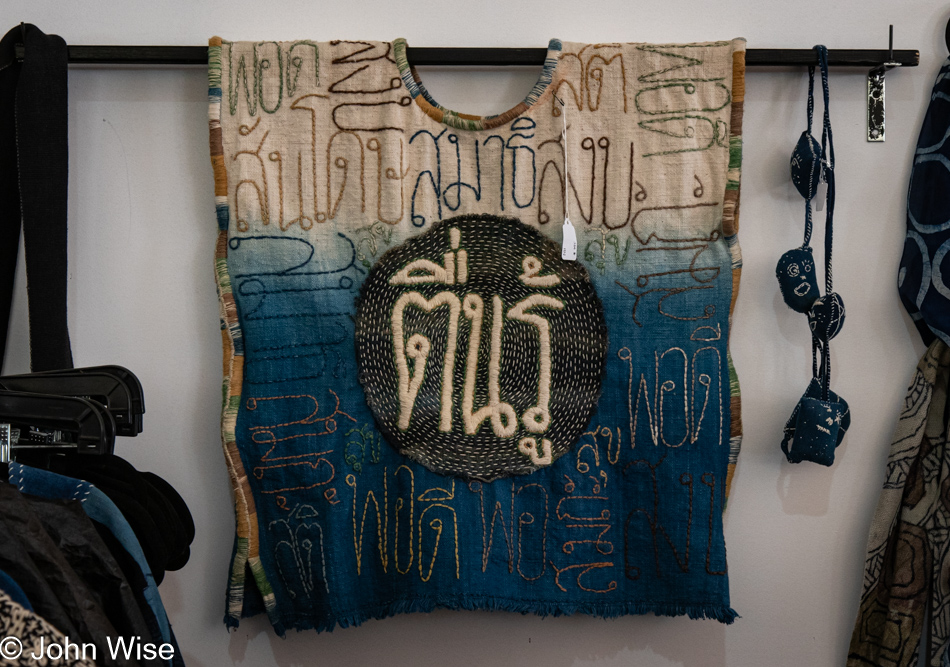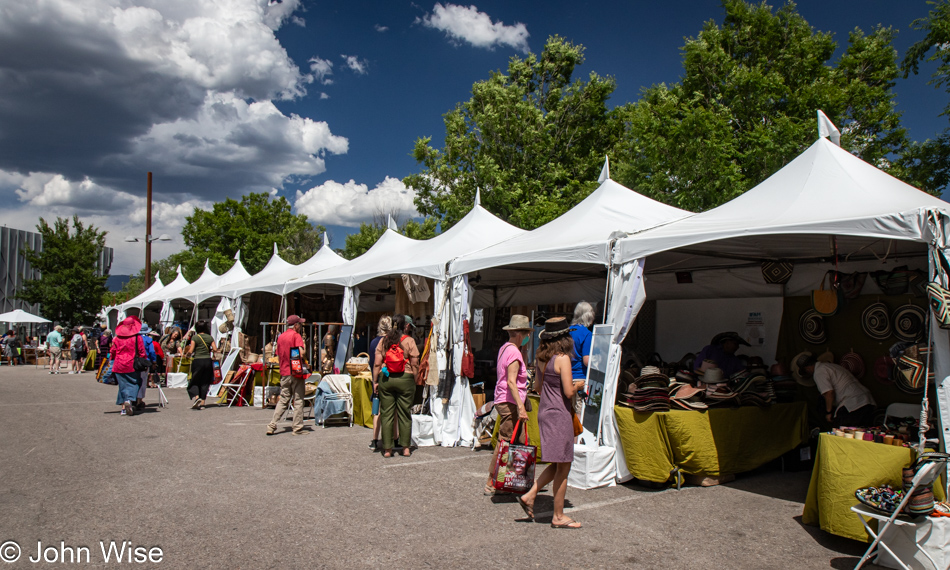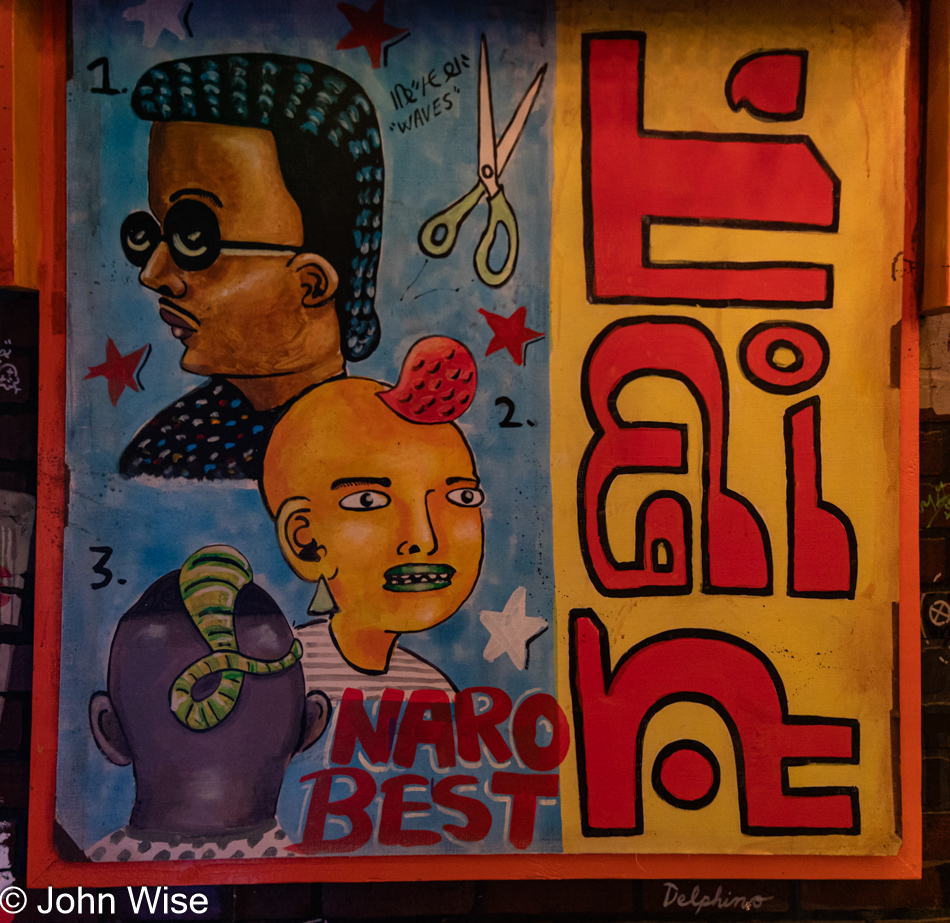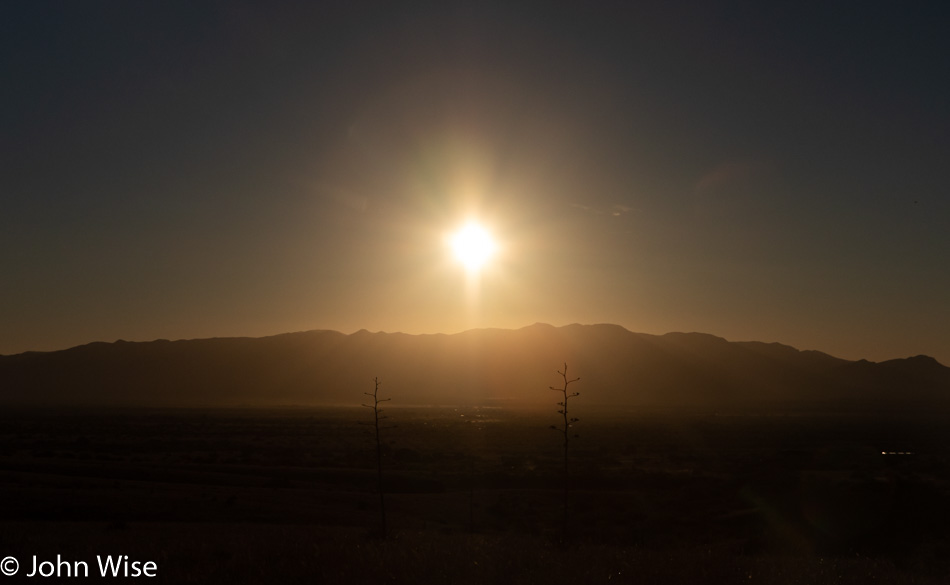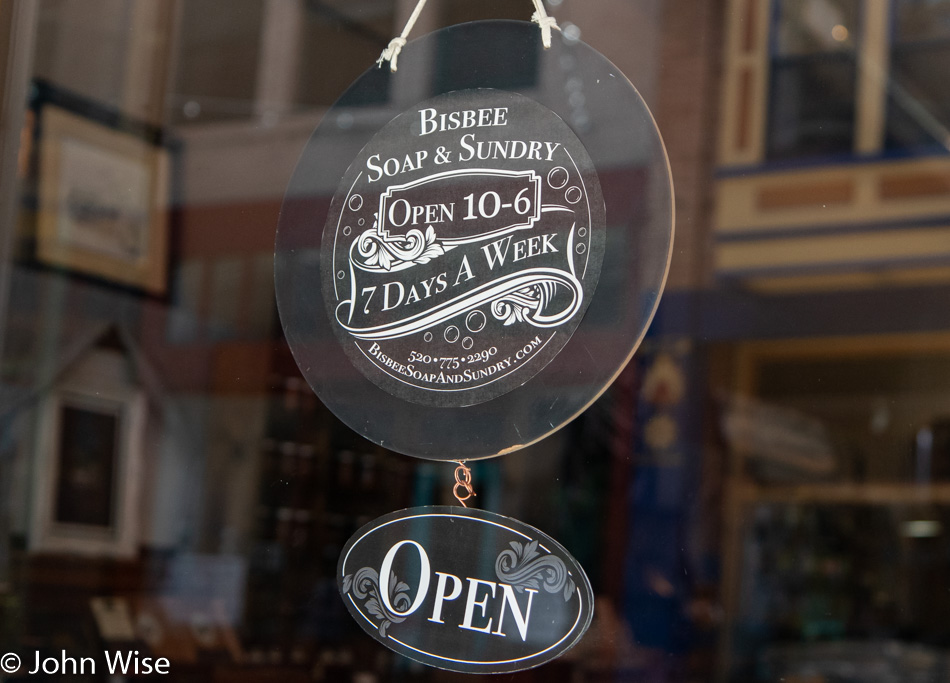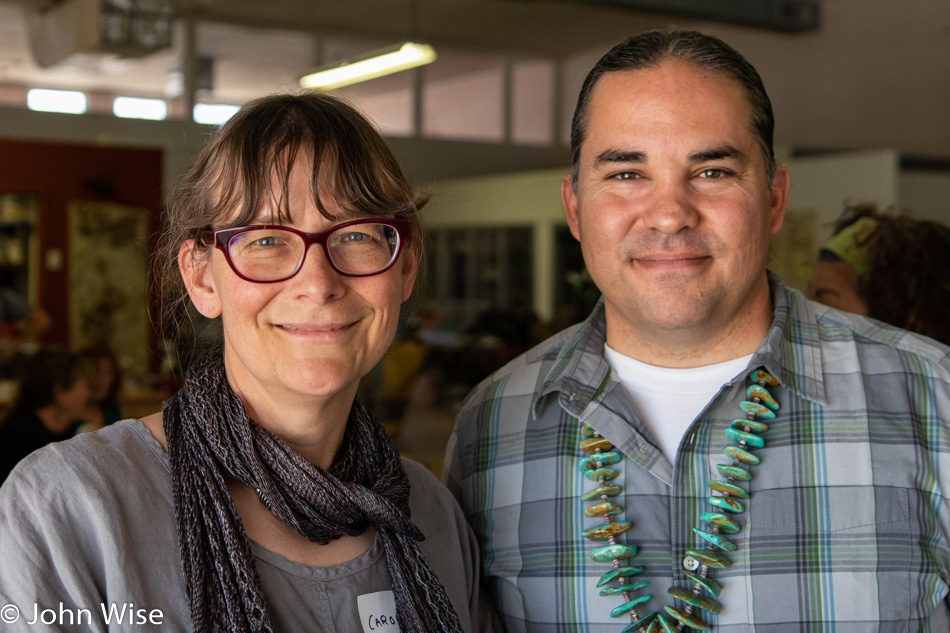
The road northeast out of Santa Fe brings visitors into the Santa Fe National Forest, and while it’s ultimately a dead end farther up the road, we are only going as far as the Big Tesuque Campground, where a trail of the same name begins and ends. If only we could find the trail. It was Alltrails that had brought this particular route to my attention, and somehow, I’m failing to see where the trailhead is, in spite of the nearby map that is useless. We ask someone who appears to be camping here, but he doesn’t know where the Big Tesuque Trail is either. Just then, across the street, a post caught my attention as the likely marker for the beginning of the trail. Bingo.
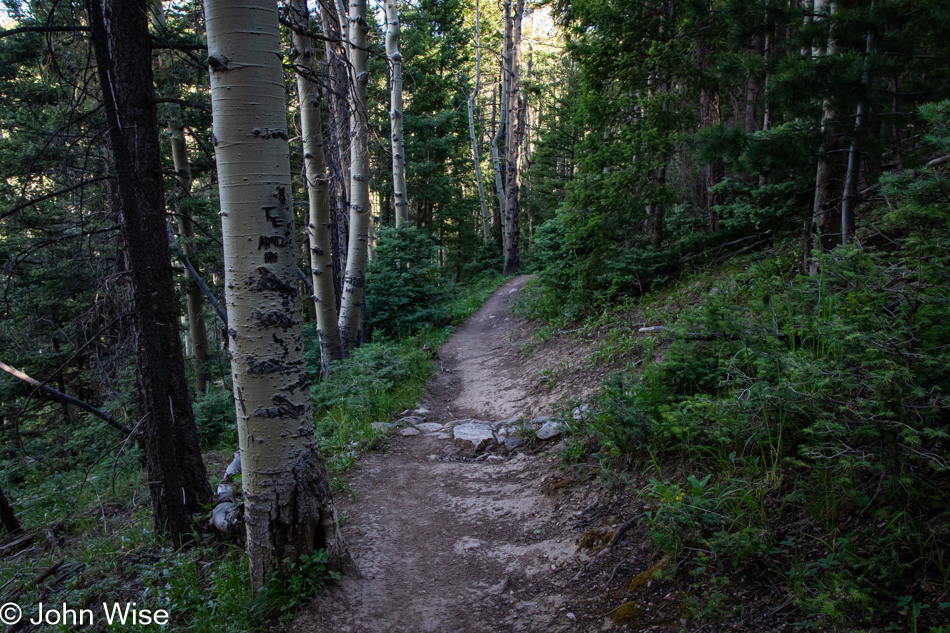
With the capital city of New Mexico just below us at about 7,200 feet, it should be no surprise that our forest route could start at 9,700 feet (2,950 meters) of elevation. What I really want to point out here is that, as we stepped from the car, the temperature was a relatively brisk 56 degrees (13 Celsius) or cold enough to our summer acclimated desert skin that a sweater was briefly considered, but no, we’d tough it out. It wasn’t only the cool air that greeted us: the nearby stream and the birds all sang songs that were music to our senses.

Oh my god! Rock, needles, shield lichen, and moss in a configuration we’ve never seen before. Isn’t the forest simply enchanted in its beauty?

This is the point on the trail where one stops to make a wish that all successive days will be just as perfect as this one.

I don’t believe Caroline has ever worn a skirt while hiking in a forest, nor has she carried her purse. This combo gives her the silhouette of a Mennonite from time to time, depending on the light upon or behind her here on the trail.

Wait a sec, I see a butterfly and am prepared to take 30 or more photos while I try my best to snap one with its wings perfectly open for me to capture the hidden message buried in the patterns I cannot decipher since I’m not a butterfly.

Nearly the same process takes place as I try to capture a selfie of Caroline and me with her eyes open, my hair not out of place, our glasses too low on our noses, no food on Caroline’s teeth, no dangling boogers, poor focus, one of us in a shadow or too bright of sun, or any of the other multitude of things that go wrong while trying to take a photo of the two of us. By the way, has anyone ever wondered if Caroline and I are roughly the same height? We are not, but when taking our photo, I bend my knees so we can appear cheek to cheek in our selfies. I also grab hold of one of her butt cheeks (which nearly always makes her laugh) before I start snapping photos and wildly moving the camera into different positions hoping that we are somewhere in the center. Some of you may think that taking a selfie is not that hard, but I would surmise that you are using your phone while I use my DSLR that; on more than one occasion, has allowed me to repair an image where lighting proved difficult, kind of like this one with the bright background. One thing I can’t take into account or fix is that we seem to be aging in our photos as the years pass.

I had a choice: share the image of the damned dental flosser Caroline spotted on the trail (yeah, seriously, a dental flosser on a forest trail because everywhere is the right place for proper dental hygiene) or the eleven cents we found. Just how we managed to see any of this perplexes us, too, but there’s proof of the change. Barely a week passes that we don’t see discarded dental flossers or pick-up change on a walk.

We could have taken this flower too and packed it between pages of a book as a keepsake, but then the next person would have been denied this beautiful scene, and seeing Caroline already pocketed not only the dental flosser and the loose change, she also picked up a stinky cigarette butt.

I’m going to put it out there that this is Pedicularis procera (giant lousewort), but we’ll let Caroline verify this as her “Search-fu” is far more attuned to perfection than any weak effort I throw at finding facts, meaning you really shouldn’t use my writing as something that arrives with any veracity. [Yes, you did get it right – this time… Caroline]

The trail guide said the walk was easy. It also said there would be only 597 feet (182 meters) of elevation gain. NO WAY, and I also don’t believe that the trail was 3.6 miles (5.8 km) long, WHATEVER.

After HOURS (1.75 hours without exaggerating), we have reconnected with the first leg of our hike, thus closing the loop, and are mere minutes away from reaching our car to head back down the hill to the International Folk Art Market.

Yellow salsify is this flower’s name, but I certainly like the other name for it better: yellow goatsbeard.

I’d mentioned the nearby stream we heard after getting out of our car; that stream flows just past the trailhead marker, and this is it right here. Its proper name is North Fork Tesuque Creek, meaning it is not actually a stream. Somehow, we lengthened the trail to 4.1 miles (6.6 km) and added a few dozen extra feet to the elevation gain, but now we’re done and need to head back to the city.
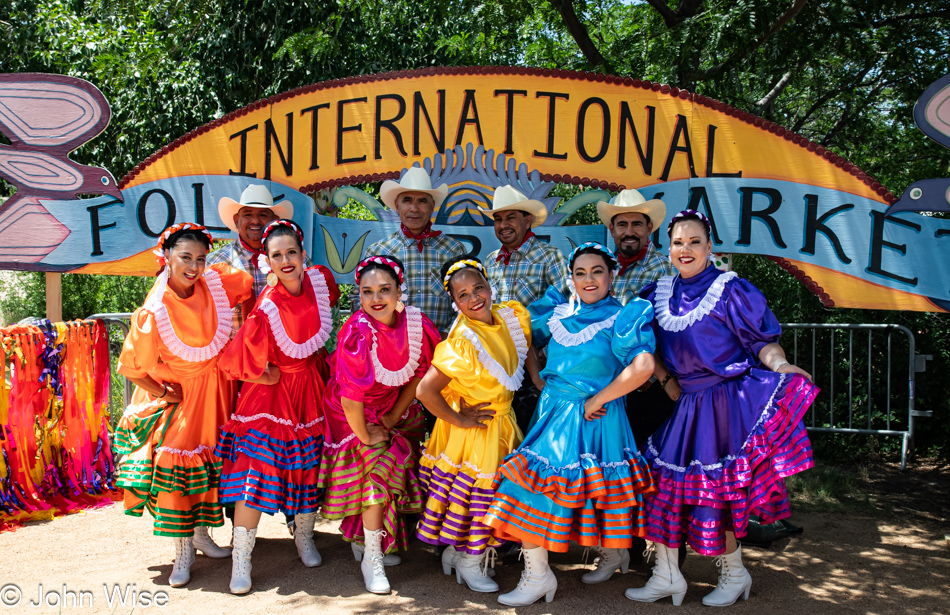
With no time to waste and following the maxim of “no rest for the wicked,” we were off the mountain and back at the market. We happened to catch this performance group having photos taken at the entrance, which reminds me that I should point out that the stage remained busy nearly all day, and in a nearby hall, talks/workshops are part of the program (for an extra charge). We attended one of the talks yesterday, but to be frank, the organizer of IFAM would be well advised to better screen and direct their speakers prior to the event. As for the performers on stage, Caroline and I did watch a few dancers from a local group perform dances, but there was not enough shaded seating available to invite us to hang out longer so we soon returned to meandering the grounds and were always on the move scouring the booths for something we might have missed.

This blog post is being put together much like a length of woven fabric: Caroline and I are the weft, and these experiences are the warp. Because we are weaving so much of ourselves into such an incredible number of experiences today, it takes forever for the thing to take shape. Had we slept in, skipped the hike, visited the market, and did little else, I wouldn’t have nearly as much to share. I could have just thrown a few threads of what the day entailed into this post, and would have been done lickety-split. Instead, there are 41 photos representing our day, with 25 of them still to be scrolled past. As for the textile being shown, it is a rachu (ceremonial scarf or sash worn by Bhutanese women on special occasions) woven by the mother of Karma Choden of Bhutan who’s standing next to Caroline.

If you ask me, I think Caroline might be basing her purchases on ideas of geography in order to figuratively travel to all these places via the fiber arts. These bracelets are made by basketry artist Crucelina Chocho of Columbia, a member of the Wounaan indigenous group, using Werregue palm fibers.

Trying to be discrete in capturing a photo of her earrings in the shape of Africa, this woman turned towards me with the smile that won “Best Smile of IFAM 2023.”

While the cloth in this stand didn’t capture Caroline’s eye, the bracelet made of black and red seeds did. Caroline’s been using a Dremel to grind holes into Texas mountain laurel seeds she wants to make into a necklace, and seeing such unique seeds from the Amazon was just the kind of thing that helped inspire her. This bracelet was made by the lady on Caroline’s right; she is Olinda Silvano of Peru.

Why one can never have enough scissors is beyond my ability to write something that could explain the mind of my wife and her collection of things with fetish value. I may never truly understand this, but these little things definitely bring her joy.

Last year at this time, the International Folk Art Market was held up here on Museum Hill. This year, it is hosted at the Railyard Park near the old town, and the museum area is awfully quiet. We are here because museum tickets are half-price for IFAM visitors this weekend, and more important than that, we were drawn in by an exhibit titled Ghhúunayúkata / To Keep Them Warm: The Alaska Native Parka at the Museum of International Folk Art.

The first collection we browsed was an ongoing exhibit called Multiple Visions: A Common Bond. There are over 10,000 artifacts from all over the world on display, and one can get lost in trying to look at everything. What is neat is that objects are not presented based on their subjects, usage, or style and are not separated by provenance, which makes connections and relationships between seemingly remote cultures apparent. Check out some of the items virtually here.

The reason behind the museum is that handcraft matters.

Last year at Meow Wolf, Caroline and I spotted a sculpture that we both thought enchanting. Of the many thousands of objects in this wing of the Museum of Folk Art, I happened to find this one that seemed familiar. Upon getting home, it turns out that there is a similarity. Click here and scroll down about 2/3rds of the page to compare this figurine to the piece in Meow Wolf and tell me if this is where the inspiration came from.

Gathering for the dead.

Gathering for the living.

We’ve arrived in the hall featuring the exhibit Ghhúunayúkata / To Keep Them Warm: The Alaska Native Parka. There are 20 parkas on display representing 6 Alaska Native communities: Dena’ina, Iñupiaq, Koyukon, St. Lawrence Island Yupik, Unangan, and Yup’ik. Along with the garments (vintage as well as contemporary), we can see drawings, dolls, tools, and more.

Who doesn’t dream of spending at least some short period of time in the Arctic and having the opportunity to wear something like this parka? As I write this on a mid-July day in Phoenix, Arizona, with temperatures hovering just below 120 degrees (49c), it is difficult to envision so much fur adorning my body (especially as a more hairless version of our species), but a naked ape can dream, can’t he?

A seal skin doll is exactly what many of us have desired; go ahead and admit it.

This St Lawrence Island Yupik ceremonial parka is made of seal gut, auklet crests, seal fur, cormorant feathers, cotton thread, and red ocher.

While this seal skin parka might make a great windbreaker, I can’t help that after an hour of sweating inside your waterproof hide; you’d smell like fish. One other thing about this garb: who else thinks it looks a bit Frankensteinish?

We can consider ourselves lucky that images such as these were painted about 100 years ago so we can glimpse a view of what life was like way up north. While life would have already changed for the indigenous people of the Arctic, this was still closer to their roots than what we’d see after film began capturing their lives.

The third exhibit we visited is titled La Cartoneria: Mexican Art of Paper and Paste and has a heavy Day of the Dead feel.

We don’t have a lot of time to dwell here in the museum due to a commitment starting at 6:00 and my impression was that we were here to see the parka exhibit. Little did I understand that all parts of the Folk Art Museum were going to be of such interest.
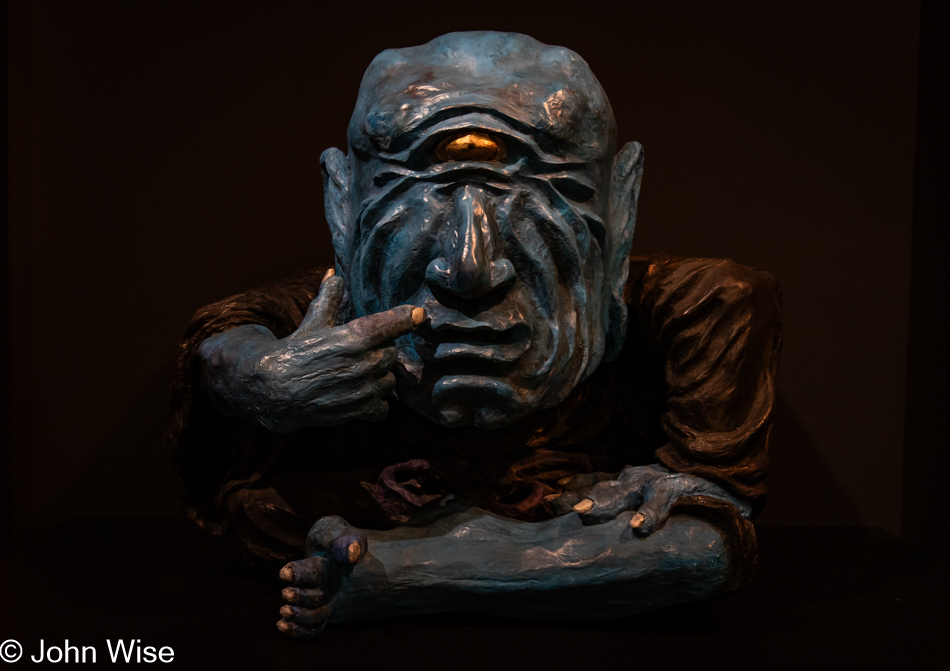
The last exhibit for us here at the museum is titled Yōkai: Ghosts & Demons of Japan.

I have to admit to only a passing interest in this exhibit, as ghosts and demons are not really my thing. In lighthearted films lampooning the subject, and in some anime, I can find appreciation, but it’s a rare day.

The utility of the subject matter for children or in entertainment is okay, but older American adults who take it all to heart and believe in it tend to make it all a bit repugnant. Obviously, that’s just me.

Our 6:00 commitment is back at the International Folk Art Market for the night segment. This was a separate entry, and while we thought we’d spent everything we were going to spend, it turns out that Caroline wasn’t finished ogling exotic clothes, and this bag from Zsuzsa Zsigmond of Hungary apparently pushed some buttons.
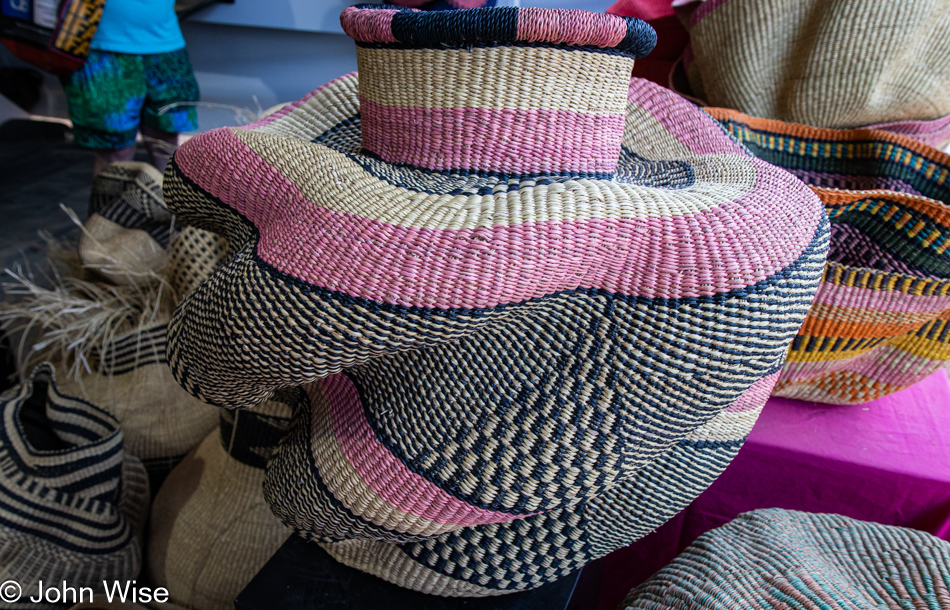
While we love these giant woven baskets from Nanasei Agyemang of Ghana, we simply do not have the space to keep one in our tiny apartment. Every time we see them in someone’s arms, they put a smile on our faces that they are so fortunate to be the new owner of such a unique basket.

You’d have to be a real nudnik not to love everything about Peruvian weavers.

Live music and a bar were part of the Night Market here at IFAM, and while we were here, this side of things had little interest for us as we were inching towards exhaustion. So, after a final walk of the vendor booths, we said goodbye to another year that saw our attendance and hopefully not our last. As a matter of fact, before finishing writing that, I went over to the IFAM website to see that they posted the dates of next year’s 20th Annual Market running from July 11th to the 14th, and so I took the opportunity and booked our rooms at Motel 6 just around the corner of the Railyard Park.
